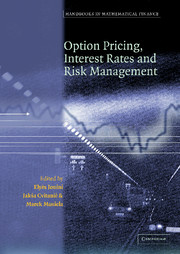Book contents
- Frontmatter
- Contents
- List of Contributors
- Introduction
- Part one Option Pricing: Theory and Practice
- 1 Arbitrage Theory
- 2 Market Models with Frictions: Arbitrage and Pricing Issues
- 3 American Options: Symmetry Properties
- 4 Purely Discontinuous Asset Price Processes
- 5 Latent Variable Models for Stochastic Discount Factors
- 6 Monte Carlo Methods for Security Pricing
- Part two Interest Rate Modeling
- Part three Risk Management and Hedging
- Part four Utility Maximization
5 - Latent Variable Models for Stochastic Discount Factors
from Part one - Option Pricing: Theory and Practice
Published online by Cambridge University Press: 29 January 2010
- Frontmatter
- Contents
- List of Contributors
- Introduction
- Part one Option Pricing: Theory and Practice
- 1 Arbitrage Theory
- 2 Market Models with Frictions: Arbitrage and Pricing Issues
- 3 American Options: Symmetry Properties
- 4 Purely Discontinuous Asset Price Processes
- 5 Latent Variable Models for Stochastic Discount Factors
- 6 Monte Carlo Methods for Security Pricing
- Part two Interest Rate Modeling
- Part three Risk Management and Hedging
- Part four Utility Maximization
Summary
Introduction
Latent variable models in finance have traditionally been used in asset pricing theory and in time series analysis. In asset pricing models, a factor structure is imposed on a collection of asset returns to describe their joint distribution at a point in time, while in time series, the dynamic behavior of a series of multivariate returns depends on common factors for which a time series process is assumed. In both cases, the fundamental role of factors is to reduce the number of correlations between a large set of variables. In the first case, the dimension reduction is cross-sectional, in the second longitudinal. Factor analysis postulates that there exists a number of unobserved common factors or latent variables which explain observed correlations. To reduce dimension, a conditional independence is assumed between the observed variables given the common factors.
Arbitrage pricing theory (APT) is the standard financial model where returns of an infinite sequence of risky assets with a positive definite variancecovariance matrix are assumed to depend linearly on a set of common factors and on idiosyncratic residuals. Statistically, the returns are mutually independent given the factors. Economically, the idiosyncratic risk can be diversified away to arrive at an approximate linear beta pricing: the expected return of a risky asset in excess of a risk-free asset is equal to the scalar product of the vector of asset risks, as measured by the factor betas, with the corresponding vector of prices for the risk factors.
- Type
- Chapter
- Information
- Handbooks in Mathematical FinanceOption Pricing, Interest Rates and Risk Management, pp. 154 - 184Publisher: Cambridge University PressPrint publication year: 2001
- 1
- Cited by



